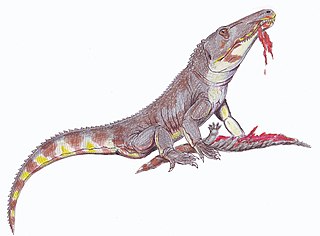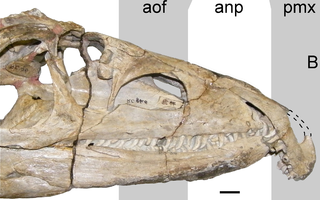
Archosauriformes is a clade of diapsid reptiles encompassing archosaurs and some of their close relatives. It was defined by Jacques Gauthier (1994) as the clade stemming from the last common ancestor of Proterosuchidae and Archosauria. Phil Senter (2005) defined it as the most exclusive clade containing Proterosuchus and Archosauria. Archosauriforms are a branch of archosauromorphs which originated in the Late Permian and persist to the present day as the two surviving archosaur groups: crocodilians and birds.

Chasmatosuchus was an archosauriform reptile from the early Triassic period of European Russia. One of the earliest described archosauriforms, it was over 2 m long and is thought to have behaved like a modern crocodile. Its mouth had two distinct features: the top of its jaw hooked downwards to aid in holding prey, and the upper palate was lined with a row of teeth—a primitive feature lost in later archosaurs.

Proterosuchidae is an early family of basal archosauriforms whose fossils are known from the Late Permian and the Early Triassic. The highest diversity of genera is known from European Russia, but fossils are also known from South Africa, India, China, Australia, Brazil and possibly Argentina. The name comes from Greek πρότερο- ("first") and σοῦχος ("crocodile").

Garjainia is an extinct genus of erythrosuchid archosauriform reptile from the Olenekian of Russia and South Africa. It was approximately 1.5–2 metres (4.9–6.6 ft) long. It contained two species, Garjainia prima from the Yarengian/Yarkenskian Supergorizont of Russia, and Garjainia madiba from the Burgersdorp Formation of South Africa. "Vjuskovia triplicostata", a name assigned to some erythrosuchid fossils from Russia, has been synonymized with Garjainia prima.

Proterosuchus is an extinct genus of archosauriform reptiles that lived during the Early Triassic. It contains three valid species: the type species P. fergusi and the referred species P. alexanderi and P. goweri. All three species lived in what is now South Africa. The genus was named in 1903 by the South African paleontologist Robert Broom. The genus Chasmatosaurus is a junior synonym of Proterosuchus.

Tasmaniosaurus is an extinct genus of archosauromorph reptile known from the Knocklofty Formation of West Hobart, Tasmania, Australia. The type species is T. triassicus. This genus is notable not only due to being one of the most complete Australian Triassic reptiles known, but also due to being a very close relative of Archosauriformes. Once believed to be a proterosuchid, this taxon is now believed to have been intermediate between advanced non-archosauriform archosauromorphs such as Prolacerta, and basal archosauriforms such as Proterosuchus. Features traditionally used to define Archosauria and later Archosauriformes, such as the presence of an antorbital fenestra and serrated teeth, are now known to have evolved prior to those groups due to their presence in Tasmaniosaurus.

Kalisuchus was a genus of basal archosauriform known from remains unearthed from the Arcadia Formation of the Early Triassic of the Crater, Southwest of Rolleston, south central Queensland, Australia. It was named after Kali, the Hindu goddess of destruction, a reference to the very fragmentary nature of its remains. The type species of Kalisuchus is K. rewanensis, which refers to the Rewan Group. The Arcadia formation is dated to the Induan age at the very beginning of the Triassic, making Kalisuchus one of the oldest archosauromorphs known in Australia.

Archosaurus is an extinct genus of carnivorous proterosuchid archosauriform reptile. Its fossils are dated to the latest Permian of Russia and Poland, it is one of the earliest known archosauriforms. The type and only species is Archosaurus rossicus, known from several fragmentary specimens which cumulatively represent parts of the skull and cervical vertebrae. It would have been 3 metres (9.8 ft) long when fully grown.
Indolyrocephalus is an extinct genus of prehistoric amphibian belonging to the family Trematosauridae. It contains a single species, I. huxleyi, from the Early Triassic Panchet Formation of India. It was initially classified in Gonioglyptus, then into its own genus Indolyrocephalus, and then back into Gonioglyptus, but is presently placed in Indolyrocephalus once again.
Gonioglyptus is an extinct genus of trematosaurian temnospondyl within the family Trematosauridae. It is known from the Early Triassic Panchet Formation of India. It contains two species: G. longirostris and G. fragilis. The species G. kokeni from Pakistan has since been reclassified into Aphaneramma.
Pachygonia is an extinct genus of temnospondyl amphibian from the Early Triassic Panchet Formation of India. It contains a single species, P. incurvata. It may potentially be a member of the family Brachyopidae.
Jaikosuchus is an extinct genus of proterosuchid archosauriform. It contains a single species, J. magnus. Fossils have been found from European Russia that date back to the upper Olenekian stage of the Early Triassic.
Tsylmosuchus is an extinct genus of proterosuchid archosauriform reptile known from Western Russia. Fossils referred to Tsylmosuchus occurred over a wide area in sediments corresponding to the Induan and Olenekian stages of the Early Triassic. Most of these fossils are fragmentary neck vertebrae which were originally reported as sharing similarities with crocodile-line archosaurs (pseudosuchians) such as Mandasuchus. As a result, Tsylmosuchus was first described as part of the family Rauisuchidae, making it supposedly one of the oldest known archosaurs. However, its fragmentary remains do not show any of the distinguishing features of rauisuchids or even pseudosuchians in general, so Tsylmosuchus has more recently been interpreted as an indeterminate archosauriform. Although three species of Tsylmosuchus have been named, they lack diagnostic traits and are probably not distinct from each other. In 2023, Tsylmosuchus was reinterpreted as a proterosuchid, specifically a member of the subfamily Chasmatosuchinae.
Vonhuenia is an extinct genus of proterosuchid, a basal archosauriform from the Early Triassic of Russia. Fossils have been found in the Vokhminskaya Formation, along the Vetluga River that are Induan in age, making Vonhuenia one of the earliest archosauriforms.
Exilisuchus is an extinct genus of archosauromorph reptile from the Early Triassic of Russia. The type species E. tubercularis was named in 1979. Fossils are known from two Russian assemblages, the Benthosuchus - Thoosuchus assemblage and the Angusaurus assemblage. Both are Olenekian in age. Although initially believed to be a proterosuchid archosauriform, a 2016 analysis found that it also shared features with tanystropheids, and thus is currently classified as Archosauromorpha incertae sedis. Due to the small amount of preserved material, this genus is sometimes considered a nomen dubium.
Gamosaurus is an extinct genus of proterosuchid archosauriform. It contains a single species, Gamosaurus lozovskii, named by Vitalii Georgievich Ochev in 1979.

Asperoris is an extinct genus of archosauriform reptile known from the Middle Triassic Manda Beds of southwestern Tanzania. It is the first archosauriform known from the Manda Beds that is not an archosaur. However, its relationships with other non-archosaurian archosauriforms are uncertain. It was first named by Sterling J. Nesbitt, Richard J. Butler and David J. Gower in 2013 and the type species is Asperoris mnyama. Asperoris means "rough face" in Latin, referring to the distinctive rough texture of its skull bones.

Manubrantlia was a genus of lapillopsid from the Early Triassic Panchet Formation of India. This genus is only known from a single holotype left jaw, given the designation ISI A 57. Despite the paucity of remains, the jaw is still identifiable as belonging to a relative of Lapillopsis. For example, all three of its coronoid bones possessed teeth, the articular bone is partially visible in lateral (outer) view, and its postsplenial does not contact the posterior meckelian foramen. However, the jaw also possesses certain unique features which justify the erection of a new genus separate from Lapillopsis. For example, the mandible is twice the size of any jaws referred to other lapillopsids. The most notable unique feature is an enlarged "pump-handle" shaped arcadian process at the back of the jaw. This structure is responsible for the generic name of this genus, as "Manubrantlia" translates from Latin to the English expression "pump-handle". The type and only known species of this genus is Manubrantlia khaki. The specific name refers to the greenish-brown mudstones of the Panchet Formation, with a color that had been described as "khaki" by the first British geologists who studied the formation.
The Panchet Formation is an Early Triassic geological formation from the Damodar Valley of India.
Samsarasuchus is an extinct genus of archosauriform reptile from the Early Triassic of India. This genus has one known species, Samsarasuchus pamelae. Samsarasuchus lived a few million years after the Permian-Triassic extinction, the largest known mass extinction event. It was a member of the Proterosuchidae, a group of successful crocodile-like reptiles that survived the extinction event and were among the earliest successful archosauromorphs.














